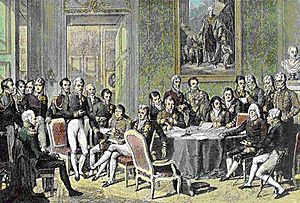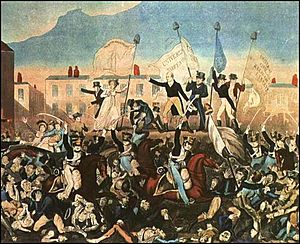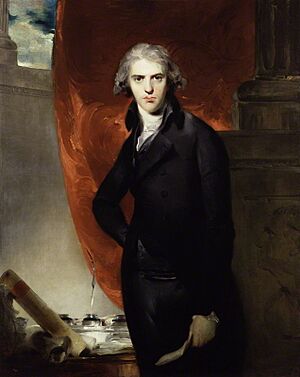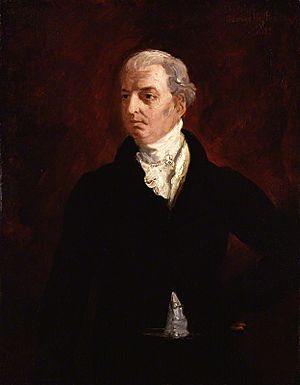Robert Jenkinson, 2nd Earl of Liverpool facts for kids
Quick facts for kids
The Earl of Liverpool
|
|
|---|---|

Portrait by Thomas Lawrence
|
|
| Prime Minister of the United Kingdom | |
| In office 8 June 1812 – 9 April 1827 |
|
| Monarch | |
| Regent | George, the Prince Regent (1812–20) |
| Preceded by | Spencer Perceval |
| Succeeded by | George Canning |
| Secretary of State for War and the Colonies | |
| In office 1 November 1809 – 11 June 1812 |
|
| Prime Minister | Spencer Perceval |
| Preceded by | The Viscount Castlereagh |
| Succeeded by | The Earl Bathurst |
| Leader of the House of Lords | |
| In office 25 March 1807 – 9 April 1827 |
|
| Prime Minister |
|
| Preceded by | The Lord Grenville |
| Succeeded by | The Viscount Goderich |
| In office 17 August 1803 – 5 February 1806 |
|
| Prime Minister | |
| Preceded by | The Lord Pelham |
| Succeeded by | The Lord Grenville |
| Home Secretary | |
| In office 25 March 1807 – 1 November 1809 |
|
| Prime Minister | The Duke of Portland |
| Preceded by | The Earl Spencer |
| Succeeded by | Richard Ryder |
| In office 12 May 1804 – 5 February 1806 |
|
| Prime Minister | William Pitt the Younger |
| Preceded by | Charles Philip Yorke |
| Succeeded by | The Earl Spencer |
| Secretary of State for Foreign Affairs | |
| In office 20 February 1801 – 14 May 1804 |
|
| Prime Minister | Henry Addington |
| Preceded by | The Lord Grenville |
| Succeeded by | The Lord Harrowby |
| Personal details | |
| Born |
Robert Banks Jenkinson
7 June 1770 London, England |
| Died | 4 December 1828 (aged 58) Kingston upon Thames, Surrey, England |
| Resting place | Hawkesbury Parish Church, Gloucestershire, England |
| Political party | Tory |
| Spouses |
Louisa Hervey
(m. 1795; died 1821)Mary Chester
(m. 1822) |
| Parent | Charles Jenkinson (father) |
| Education | Charterhouse School |
| Alma mater | Christ Church, Oxford |
| Signature | |
Robert Banks Jenkinson, the 2nd Earl of Liverpool (born June 7, 1770 – died December 4, 1828), was a very important British politician. He belonged to the Tory party. He served as the Prime Minister of the United Kingdom from 1812 to 1827. This was a long time for a prime minister!
Before becoming prime minister, he held many other key jobs. These included Foreign Secretary (in charge of relations with other countries), Home Secretary (in charge of law and order at home), and Secretary of State for War and the Colonies (in charge of the military and British colonies). He was also a member of the House of Lords and led that part of Parliament.
As prime minister, Lord Liverpool faced many challenges. He had to deal with the country after the Napoleonic Wars. These wars had caused a lot of problems and unrest. He also had to manage the country when King George III was too ill to rule. Later, he worked with the Prince Regent, who became King George IV.
Lord Liverpool tried to find a balance between different groups in Britain. He supported both businesses and landowners. He also tried to find a solution to the difficult issue of Catholic emancipation. This was about giving more rights to Roman Catholics. As the economy got stronger, his political position became more secure.
In the 1820s, he led a group of "Liberal Tories." They worked to lower taxes on imported goods and change criminal laws. For example, they reduced the number of crimes punishable by death. Many experts today think he was a very skilled leader. However, some people at the time, like Benjamin Disraeli, called him "the Arch-mediocrity."
Important events during his time as prime minister included the War of 1812 with the United States. He also saw the end of the Napoleonic Wars at the Congress of Vienna. Other key moments were the Corn Laws, the Peterloo Massacre, and the ongoing debate about Catholic rights.
Contents
Early Life and Education
Robert Banks Jenkinson was born in London on June 7, 1770. He was the son of Charles Jenkinson, who was a close advisor to King George III. Robert's mother, Amelia Watts, sadly died shortly after he was born.
He went to Charterhouse School and then to Christ Church, Oxford University. In 1789, he spent four months in Paris to improve his French. He also wanted to gain more social experience. He finished his studies at Oxford in May 1790.
Starting His Political Career
In 1790, Robert Jenkinson was elected to the House of Commons for the area of Rye. He was too young to take his seat in Parliament at first. So, he traveled around Europe, visiting the Netherlands and Italy. He was old enough to join Parliament by 1791 or 1792.
Thanks to his father's help and his own talent, he quickly moved up in the Tory government. In 1792, he spoke in Parliament about the government's policies. He also spoke against ending the slave trade, which was a view his father strongly held. From 1793 to 1796, he worked on the Board of Control for India.
When France and Britain went to war, Jenkinson joined the militia. In 1794, he became a Colonel in the Cinque Ports Fencibles. His military duties meant he was often away from Parliament.
In 1797, during a protest against the Militia Act in Tranent, Scotland, there was a violent event. Lord Hawkesbury (as he was then known) was blamed by some for not being present to prevent the soldiers' actions.
In 1795, he married Lady Louisa Hervey. His father had initially opposed the marriage, but the King and Prime Minister Pitt helped convince him. In 1796, his father became the Earl of Liverpool, and Robert took the title Lord Hawkesbury. In 1803, he became Baron Hawkesbury himself and moved to the House of Lords. This was to recognize his work as Foreign Secretary. He also served as Master of the Mint from 1799 to 1801.
Becoming Prime Minister
In May 1812, the Prime Minister, Spencer Perceval, was assassinated. Lord Liverpool was then chosen to take his place. The Prince Regent (who would later become King George IV) officially made Liverpool prime minister on June 8, 1812.
Liverpool's government included many future important British leaders. These included Lord Castlereagh, George Canning, the Duke of Wellington, and Robert Peel. Lord Liverpool was very skilled at keeping different parts of the Tory party working together. This was something his successors found very difficult.
Wars and Peace in Europe
Lord Liverpool's time as prime minister was full of major events. The War of 1812 with the United States happened during his leadership. Also, the final battles of the Napoleonic Wars were fought. The Duke of Wellington led the British army to victory against France. After France was defeated, Lord Liverpool received a special honor, the Order of the Garter.

At the peace talks, known as the Congress of Vienna, Liverpool wanted to make sure countries like the Netherlands, Spain, and Portugal stayed independent. He also wanted to keep France within its old borders. He was even willing to give back British colonies to achieve this peace. His efforts helped bring many years of peace to Europe.
Challenges at Home: Economy and Unrest
Agriculture was a big problem in Britain. Good harvests meant lower prices for crops, which hurt farmers. In 1815, the government passed the Corn Laws. These laws stopped foreign wheat from being imported until the price of British wheat reached a certain level. Lord Liverpool generally believed in free trade, but he accepted these laws to help farmers during a difficult time.
The country's finances were also a huge challenge. The cost of the wars had greatly increased the national debt. Taxes had to go up to pay off this debt. This led to a lot of unrest and protests between 1812 and 1822.
Groups like the Luddites protested by destroying new industrial machines. They felt these machines were taking their jobs. Many people involved in these protests were severely punished.

In 1817, the government believed there were organized groups trying to cause trouble. They temporarily suspended Habeas corpus, which meant people could be arrested and held without trial. After the Peterloo Massacre in 1819, where soldiers attacked peaceful protesters, Liverpool's government passed the Six Acts. These laws limited things like free speech and the right to gather for protests. Because of these strict measures, some people even planned to assassinate Liverpool and other ministers in the Cato Street conspiracy in 1820, but the plot was stopped.
Despite these tough measures, Lord Liverpool also supported some reforms. He argued for ending the slave trade at the Congress of Vienna. At home, he supported ending the Combination Laws in 1824. These laws had prevented workers from forming trade unions.
The Catholic Emancipation Debate
During the 19th century, one of the biggest arguments in British politics was about Catholic emancipation. This was about whether Roman Catholics should have the same political rights as Protestants. Lord Liverpool believed that because the monarch was linked to the Church of England, and Catholics wouldn't take certain oaths, they should not have political power. He was against full Catholic emancipation throughout his career.
However, he did support some small changes. For example, he thought English Roman Catholics should be allowed to join the higher ranks of the army and become judges. But he did not want them in Parliament.
By the 1820s, there was growing pressure for Catholic emancipation. The Catholic Association in Ireland was very active. In 1825, a bill to grant more rights to Catholics passed in the House of Commons. This made Lord Liverpool feel it was time for him to retire. He stepped down on April 9, 1827. George Canning became the next Prime Minister. Full Catholic emancipation finally happened in 1829, after Liverpool's death.
Later Life and Legacy
Lord Liverpool's first wife, Louisa, passed away in 1821. He married again in 1822 to Lady Mary Chester, a friend of his first wife. This marriage lasted seven years until his death.
Lord Liverpool retired on April 9, 1827, after suffering a severe stroke. He had another stroke in July and passed away on December 4, 1828. He had no children. His younger half-brother, Charles Cecil Cope Jenkinson, 3rd Earl of Liverpool, inherited his title. Robert Banks Jenkinson was buried in Hawkesbury parish church in Gloucestershire.
Lord Liverpool was the first British Prime Minister to regularly wear long trousers instead of knee breeches. He also started the trend of having a short haircut instead of long hair tied in a queue. He became prime minister at 42, making him younger than all his successors. He was also the longest-serving Prime Minister of the 19th century.
Several places are named after him, including Liverpool Street and Liverpool Road in London. The Canadian town of Hawkesbury, Ontario, and the Hawkesbury River in Australia are also named in his honor.
Images for kids
-
The British Empire at the end of the Napoleonic Wars in 1815
See also
 In Spanish: Robert Jenkinson para niños
In Spanish: Robert Jenkinson para niños






